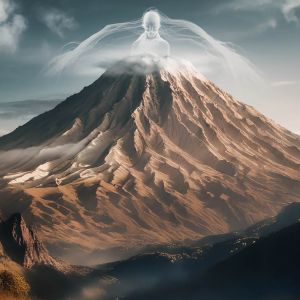Orak-Thun
| Orak-Thun | |
|---|---|
| Image |  |
| Represents | Enduring selfhood through geological time |
| Realm | Terasil |
| Location | The outer spine of the Citadel Mountains |
Introduction
Orak-Thun is an ancestral spirit believed to be the first sentient mountain, whose awareness emerged before the rise of mortals. Unlike other spirits that move through the world, Orak-Thun is the world—rooted, vast, and unmoving. According to Orasian myth, it achieved consciousness not through divine spark but by enduring the passage of time without breaking. Though it once spoke, shaping laws and paths with its voice, Orak-Thun has since fallen into a deep silence, now existing as both myth and geography in the Citadel range.
Domain and Manifestation
Orak-Thun’s domain is identity without motion—the preservation of self in the absence of change. It does not manifest as a figure, sound, or event, but as the totality of its form. Pilgrims speak of the feeling of being watched from within the rock itself. Geologically, Orak-Thun is a distinct peak within the Citadel Mountains: unusually symmetrical, seismically inert, and surrounded by weather patterns that seem to avoid its summit.
Cultural Significance
To the Orasians, Orak-Thun is both ancestor and origin. It is said to have named the first paths of stonecraft and defined the lines of early Orasian society. Its enduring presence is cited in philosophical traditions that emphasize patience, internal integrity, and the refusal to be shaped by passing forces. No stone is ever taken from Orak-Thun’s body, and no structure is built upon it. The mountain is treated as sovereign—entirely itself, beyond stewardship.
Legends and Accounts
One legend claims that Orak-Thun once spoke to a council of Orasian elders during the early Age of Erosion, uttering a single phrase that redirected the city of Kar-Thal to its current location. Another tale tells of a Minthari pathfinder who vanished during an expedition, only to reemerge decades later, claiming he had stood in the mountain’s memory and returned unchanged. Even today, seers claim that Orak-Thun’s dreams shape the subterranean flow of stone beneath Terasil.
Depictions in Art
Though rarely depicted in figurative form, Orak-Thun appears frequently in Orasian visual tradition as a symbol of stillness and continuity. Most representations focus on **shape, weight, and silence** rather than image.
Stonecarvers often embed asymmetrical outlines of Orak-Thun into civic halls, not to display reverence, but to acknowledge unchanging presence. Lorewardens record entire harmonic sequences inspired by its contour, some of which are played during silence rites in Surnaketh.
No Orasian artist has claimed to represent Orak-Thun directly—only to echo its shape or absence. To depict it fully is considered presumptuous, as its identity lies beyond all interpretation.